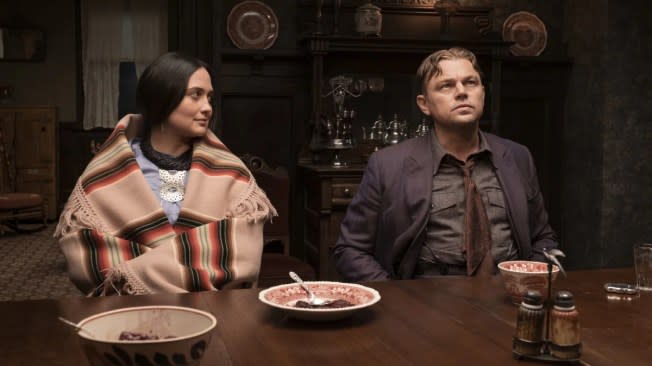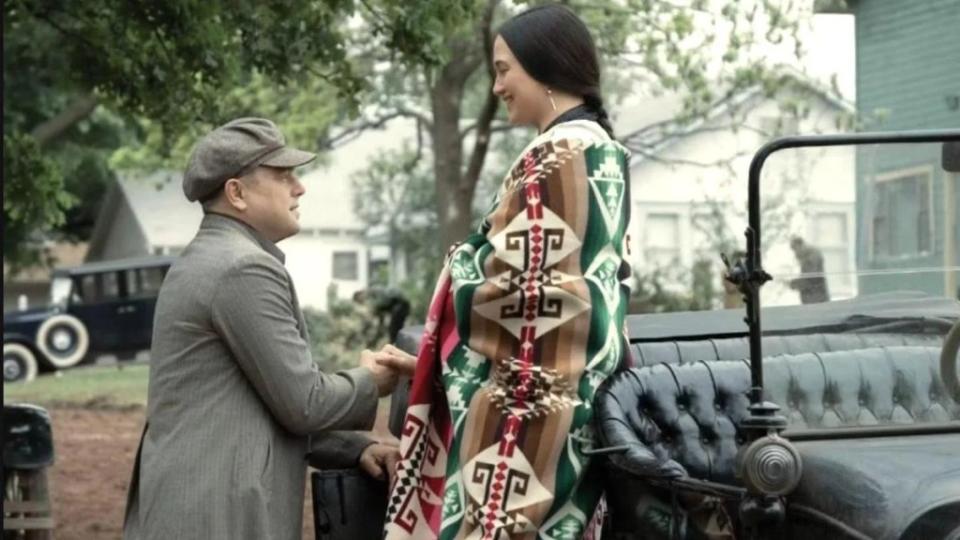Cinematographer Rodrigo Prieto Had to Explore ‘My Own Darkness’ When Filming ‘Killers of the Flower Moon’
- Oops!Something went wrong.Please try again later.
- Oops!Something went wrong.Please try again later.
Rodrigo Prieto has been on quite a journey over the past year. In 2022, he spent months on the plains of Oklahoma working in blistering hot weather with Martin Scorsese as DP of “Killers of the Flower Moon,” a dark retelling of murder and racism from the early 20th century.
Then, immediately after, he flew off to London to help Greta Gerwig create the colorful world of “Barbie.” Making such wildly different films requires differing approaches, but Prieto told TheWrap that his philosophy as a cinematographer connected the two films together.
“As a cinematographer, I tap into my own psyche, into my own inner worlds,” he said. “For ‘Killers of the Flower Moon, it was certainly an exploration of my own darkness, my own conflicts, and then I try to put that on the screen and try to understand what of these characters is in me as well.”
“In the same way when I’m doing ‘Barbie,’ I’m thinking, ‘What could it be like to be a toy who thinks everything is perfect?’ So I tapped into my own view of the world as a child, my memories of getting a toy at Christmas,” he added.
That sense of empathy has been Prieto’s guiding star during his 35-year career as a DP, one that has seen him work with the likes of Spike Lee (“25th Hour”), Ang Lee (“Brokeback Mountain,”) and Alejandro Inarritu (“Babel”), among many others. “Killers of the Flower Moon” is Prieto’s fourth feature collaboration with Scorsese, but one that required more work than any of the ones that had come before.
Prieto discussed his work on “Killers of the Flower Moon,” plus his upcoming directorial debut “Pedro Paramo,” in the interview below. The interview has been edited for clarity.
TheWrap: You have many years of experience working with Martin Scorsese on his films. Have you developed a system together as director and cinematographer over the course of those past films and did that come into play when shooting “Killers of the Flower Moon”?
Rodrigo Prieto: When we first met on “Wolf of Wall Street” I remember one of the first things he said was he hadn’t figured out the look of the movie yet, and I found that really interesting, refreshing and unexpected. His movies have always been so powerful in terms of the imagery and the way he communicates with the camera; so to hear him say that he hadn’t really figured that part out felt like an opening for me to suggest some ideas and get the conversation going.
At our next meeting I brought a series of images, still photographs, conceptual ideas. We started from there and then it kept evolving until he actually sat down and did a shot list for the whole film. I think that shot list is the one common characteristic with every film. When he makes it, every scene is planned out, sometimes with diagrams, sometimes with drawings, and then he describes and explains that shot list to me and that becomes my Bible.

That happened as well on “Killers,” but the process was longer because the script kept evolving. Things were being rewritten as we worked, even on the day of shooting. For example, the scene where Molly and Ernest are at dinner and the storm starts happening and she tells him to sit still and feel the storm, that wasn’t in the script. That came up maybe two or three days before we actually shot the scene, which was supposed to be during the day according to the script.
So, now that it was happening before a storm we had to change the windows, make the tents bigger to accommodate for the rain effect and the lightning. There were a lot of scenes where we had to make those very quick changes on the fly, and that really kept me on my toes in a way that was different from any other film I did with Martin.
Scorsese has spoken a lot about how the crew’s meetings with the Osage prior to the start of filming significantly changed his vision of the film. Did those meetings influence your approach as a DP?
We were invited to a dinner with perhaps around 250 Osage and it was a deep honor. I started learning about their cosmology and their spirituality, about how connected they are to nature and how the movement of the sun through the sky is an important factor for them.
In their rituals, for example, there’s the prayers at dawn, towards the sun, the burials at noon with the sun at its zenith. I tried to incorporate the sun into scenes, even when they’re inside, and bring that presence of nature, into, let’s say, the bark lodge in the beginning, when there’s a ceremony with a pipe. Later on, there’s a bigger meeting, a council meeting about the murders, and I brought a big beam of sun into the center of it. This is artificial cinema lighting but it represents their connection to the sun.

Death is also present in every part of this film, as it is with many of Scorsese’s films. How did you approach depicting the violent scenes throughout this film?
Well, there’s certainly a dispassionate way in which the camera portrays these murders because that’s also the way they were executed. We kept the camera in angles that weren’t showing these killings in an exciting way. We photographed the bodies of the murdered Osage from above, again, very graphic, very simple, but respectful of just showing the body and the way the frame becomes the coffin.
We also use these petzval lenses that have a distortion on the edges. Those were lenses that were used in that era in still photography, so we had them adapted for Panavision cameras and we used them for the scenes when Molly’s sisters are dying and when Molly herself is close to death. It became a motif throughout the film, a visual way of evoking the presence of death.
Are there any scenes in the film that you are particularly proud of?
It would be the scene where William Hale is burning the land around his farm to collect insurance money. It’s just another scheme for Hale, but for Ernest it symbolizes him falling into his own hell. We see William Hale overseeing this, this firescape, looking like the devil himself as he looks out at the silhouettes of his workers stoking the fire.
We also see Ernest staring in horror at the fire, as he’s wrought with guilt about poisoning Molly. He’s watching the fire from his own house in Fairfax, which is unrealistic, but having that firelight against his face just shows how Hale’s influence has consumed him. The look of the film is transformed from a form of naturalism into something subjective and a little surreal through the cinematography.
There’s some shots we did through the heat waves of the fire, of the stunt people playing the workers in Hale’s ranch trying to keep the fire from burning the house down. There was a choreography done with them which could be seen through the distortion of the heat waves of the fire. I was very excited when we shot it because I didn’t expect it to have that level of distortion, but it just happened that way. By focusing the lenses on the heatwave, instead of on the people, it gave it a very special energy that works for that moment in the movie. It’s one of those things that wasn’t exactly planned to be precisely like that, but it happened and those are those certain serendipity moments I find truly exciting as a cinematographer.

You spoke about how you find a part of yourself in the characters you shoot and now you are working on postproduction for your directorial debut shot in your home country of Mexico. What can you tell us about that project and how personal it is for you?
“Pedro Paramo” is an adaptation of a very, very famous Mexican novel, the kind of novel that everybody reads in high school. A lot of people asked me, “How do you dare do this? This is not easy, right?” But I was very connected to this novel ever since I read it in high school. It happens during the time of the Mexican Revolution and the main character, Juan Preciado, goes to this town in search of a father he never met and to try and understand his roots.
For me, it was a personal exploration of my ancestors and my past in Mexico. We shot in San Luis Potosi, which is where my grandfather’s from, and I once again asked myself what is in each of these characters, created by Juan Rulfo, that’s a part of me? Even Pedro Paramo, the main character, you could consider him an evil landowner, but I wanted to explore what is in the soul of this man and that I can connect to somehow.
So, all the characters, there was a little piece of me in all of them. I co-shot the film with Nico Aguilar. We did the cinematography together, so it was a lot of work, but I enjoyed it thoroughly and I hope it turns out good.
“Killers of the Flower Moon” is now playing in theaters.
The post Cinematographer Rodrigo Prieto Had to Explore ‘My Own Darkness’ When Filming ‘Killers of the Flower Moon’ appeared first on TheWrap.

